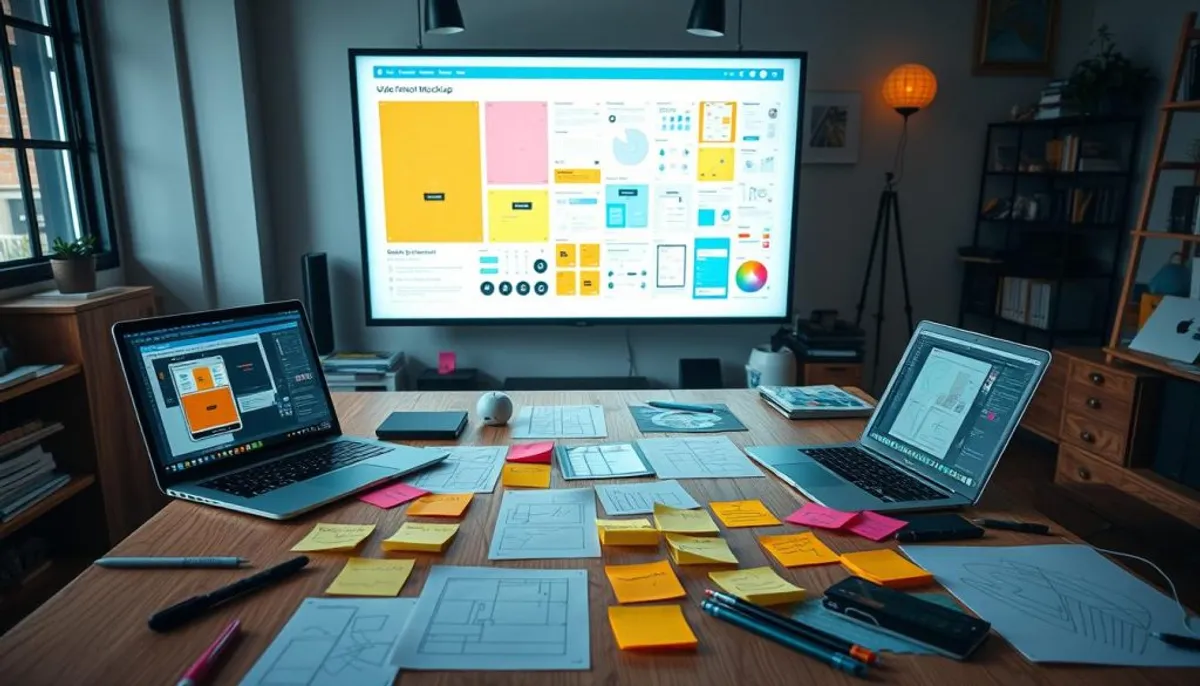UI and UX are integral components of digital design, yet their distinctions often confuse many. This exploration clarifies the unique roles of user interface and user experience in crafting compelling digital products.
These disciplines synergize to create exceptional digital interactions. UI emphasizes visual aesthetics, while UX ensures a seamless and meaningful user journey.

UI ux design merges visual appeal with user-centric functionality. Both elements are crucial for developing successful digital experiences. They collaborate to enhance product usability and user satisfaction.
Don Norman, who coined “user experience” in 1988, defines UX as encompassing all user interactions with a company’s offerings. Conversely, UI represents the visual interface where users engage with digital devices.
UI focuses on elements like buttons, icons, and color schemes. It shapes the visual landscape users navigate. UX, however, extends beyond visuals to optimize the entire user journey.
Key Takeaways
- UI and UX are distinct but complementary disciplines in digital design
- UI focuses on visual elements, while UX ensures overall user satisfaction
- Both UI and UX designers play vital roles in product development
- Successful digital products require a blend of UI and UX principles
- Understanding the differences between UI and UX can lead to better design outcomes
Introduction to UI and UX Design
Since the 1970s, digital interfaces have undergone a remarkable transformation. UI and UX design now shape our digital experiences profoundly. These disciplines have revolutionized our interaction with technology, enhancing its intuitiveness and user-friendliness.
Defining User Interface (UI) Design
UI design concentrates on visual elements users interact with on digital platforms. It aims to create appealing and functional interfaces. UI designers craft buttons, icons, and layouts to ensure seamless user-product interactions.
Defining User Experience (UX) Design
UX design, a concept from the early 1990s, encompasses the entire user journey. UX designers conduct user research, create prototypes, and test designs. They collaborate with various teams to enhance product usability and user satisfaction.
The Importance of UI and UX in Digital Design
UI and UX are fundamental to successful digital products. UI enhances visual appeal, while UX ensures effective user need fulfillment. Together, these professionals create products that are both aesthetically pleasing and highly functional.
Their combined efforts foster user loyalty and positive experiences. This synergy results in digital products that truly resonate with users.
| Aspect | UI Design | UX Design |
|---|---|---|
| Focus | Visual elements | Overall user journey |
| Key Tasks | Creating layouts, buttons | User research, prototyping |
| Goal | Aesthetic appeal | User satisfaction |
The Evolution of UI and UX Design
UI/UX design has undergone a remarkable transformation. From rudimentary command-line interfaces to sophisticated graphical ones, the field has experienced exponential growth. In 1963, Ivan Sutherland’s Sketchpad pioneered graphical user interfaces, setting the stage for future innovations.
The 1970s introduced the Xerox Alto, featuring groundbreaking elements like icons, windows, and pointers. These innovations laid the foundation for personal computing. Apple’s Macintosh (1984) and Microsoft’s Windows (1985) democratized graphical user interfaces, revolutionizing UI/UX processes.
The 1990s internet boom necessitated user-friendly, navigable websites. This shift reshaped UI/UX design priorities. The new millennium embraced minimalist design and user-centric principles, molding contemporary UI/UX methodologies.
Currently, AI, AR, VR, and MR are spearheading immersive UI/UX experiences. These cutting-edge technologies foster intuitive, personalized interfaces. Consequently, they’re expanding the horizons of digital design possibilities.
| Year | Milestone | Impact on UI/UX Design |
|---|---|---|
| 1963 | Sketchpad | First graphical user interface |
| 1970s | Xerox Alto | Introduced icons, windows, and pointer |
| 1984 | Apple Macintosh | Popularized GUIs for broader audience |
| 1985 | Microsoft Windows | Brought GUIs to the masses |
| 2007 | iPhone launch | Shifted focus to touch interfaces |
Core Principles of UI Design
UI design is vital for creating appealing and user-friendly interfaces. Mastering core principles enables crafting effective digital products. These key elements shape successful UI design.
Visual Design Elements
Color schemes, typography, and layouts form UI design’s foundation. A well-chosen color palette can boost website conversion rates significantly. Typography impacts readability and accessibility, while layouts guide users through interfaces.
UI designers create visually striking elements aligning with brand identity and user preferences. These components work together to enhance the overall user experience.
Interactive Components
Buttons, menus, and forms are crucial interactive elements in UI design. They should be intuitive and easy to use. Designers must consider user behavior when crafting these components.
Effective feedback mechanisms provide clear responses to user actions. This enhances overall usability and engagement, creating a more satisfying interface.

Responsive Design Considerations
Responsive design is critical in today’s multi-device world. Interfaces must adapt seamlessly to various screen sizes and devices. This flexibility ensures consistent user experiences across platforms.
Implementing best practices in responsive design creates functional and visually appealing interfaces. These designs work effectively on desktops, tablets, and mobile phones.
Focusing on these principles helps UI designers create exceptional interfaces. Strong UI design combined with effective UX can significantly boost website conversion rates. This highlights the importance of mastering these principles in digital product development.
Fundamental Concepts of UX Design
UX design crafts meaningful user experiences through understanding people’s needs. Designers employ various ui ux processes to achieve this goal. The discipline revolves around creating products that resonate with users on multiple levels.
User-centered design forms the core of UX philosophy. This approach prioritizes users in every decision-making process. Designers must develop empathy, grasping users’ goals and pain points. They conduct extensive research to construct user personas and map out journeys.
Information architecture plays a pivotal role in UX design. It involves structuring content logically, facilitating easy navigation for users. This organizational strategy ensures people can effortlessly find what they need.
Usability and accessibility are paramount in UX design. Products should be intuitive for everyone, including those with disabilities. Designers also consider the emotional impact of their creations on users.
| UX Design Concept | Description |
|---|---|
| User-Centered Design | Puts users first in every decision |
| Empathy | Understanding user goals and pain points |
| Information Architecture | Organizing content for easy navigation |
| Usability | Ensuring products are easy to use |
| Accessibility | Making products usable for all, including those with disabilities |
These fundamental concepts steer UX designers through various ui ux methodologies. By implementing these principles, they develop products that genuinely fulfill user needs. The result is a satisfying and meaningful experience for the end-user.
The UX Design Process
UX design is a methodical approach to creating user-centered products. It comprises several crucial stages that work in tandem to ensure a smooth user experience. Let’s examine the core UI UX methodologies shaping this process.
User Research and Analysis
UX designers begin by collecting data on users’ needs, behaviors, and pain points. They employ various tools like surveys and interviews to construct user personas and journey maps. This research serves as the cornerstone for all subsequent design choices.
Information Architecture
Designers then organize content and features into a coherent structure. They develop sitemaps and user flows to enhance information accessibility. This step is vital for improving navigation and overall usability of the product.
Wireframing and Prototyping
The next phase involves creating low-fidelity wireframes to visualize layout and functionality. These wireframes evolve into interactive prototypes for early testing. Many designers prefer tools like Axure RP, which integrates seamlessly with Figma and Sketch.
User Testing and Iteration
The final stage entails testing prototypes with actual users. Designers collect feedback, analyze results, and implement necessary improvements. This iterative process ensures the final product aligns with user needs and expectations.
Adhering to these UI UX processes allows designers to craft products that are both visually appealing and intuitive. The ultimate aim is to address user needs effectively, boost loyalty, and uncover opportunities for growth.
UI Design: From Mockups to Final Product
UI designers transform UX concepts into visually striking interfaces. They craft high-fidelity mockups that showcase a product’s final appearance. This process encompasses selecting color schemes, typography, and designing interactive elements.
Mockups are static representations of the final product. They typically follow wireframes but experienced designers may skip low-fidelity stages. Three primary tools generate mockups: graphic design software, mockup apps, and coded mockups.

UI designers adhere to best practices when creating mockups. These include adopting mobile-first approaches and utilizing component libraries. Effective collaboration between designers and developers ensures smooth handoff processes.
| UI Design Element | Purpose | Impact on UX |
|---|---|---|
| Color Palette | Brand consistency | Emotional response |
| Typography | Readability | Information hierarchy |
| Interactive Elements | User engagement | Ease of navigation |
UI designers maintain product consistency and align visual design with brand guidelines. They collaborate closely with developers to implement designs effectively. Creating design systems for scalability often forms part of their responsibilities.
This collaborative approach in UI/UX design drives successful product development. It ensures a cohesive and visually appealing final product that meets user needs and expectations.
Differences Between UI and UX
UI and UX are vital components in digital design, each focusing on distinct aspects of user satisfaction. UI enhances visual appeal and interactivity, while UX ensures a seamless user journey and problem-solving.
Focus and Objectives
User interface design creates visually appealing and interactive interfaces. User experience design solves user problems and ensures a smooth journey through the product. Both aim to enhance overall user satisfaction.
Skill Sets Required
UI designers need strong visual design skills and knowledge of interaction principles. They transform wireframes into polished interfaces, focusing on typography, colors, and responsiveness.
UX designers require research skills, empathy, and an understanding of human behavior. They plan user flows, conduct research, and create information architecture to optimize the user experience.
Deliverables and Outputs
UI professionals produce visual mockups, interactive prototypes, and design systems. UX designers deliver user research reports, wireframes, and user flow diagrams. Both roles contribute significantly to product development through their unique approaches.
| Aspect | UI Design | UX Design |
|---|---|---|
| Focus | Visual elements, interactivity | User journey, problem-solving |
| Key Skills | Visual design, prototyping | Research, empathy, analysis |
| Deliverables | Mockups, design systems | Wireframes, user flows |
| Average Salary (US) | $91,901 | $94,614 |
The Synergy of UI and UX in Product Development
UI and UX collaboration forms the backbone of successful digital products. UX designers conduct user research and create information architecture. UI designers then transform these concepts into visual elements. This teamwork ensures products are functional and visually appealing.
Implementing UI/UX best practices from the start leads to informed decision-making. Early brainstorming sessions establish a shared vision for successful cooperation. UX researchers conduct user interviews and usability testing, providing valuable data for UI designers.
The collaboration between UX and UI professionals is iterative. It involves constant feedback, testing, and refinement to meet user needs. Empathy mapping exercises help both teams understand user motivations, informing design decisions.
UX and UI professionals participate in collaborative design workshops to foster shared ownership. These sessions allow both teams to contribute their expertise effectively. This approach enhances team dynamics and overall product success.
Integrating UX principles and UI elements creates aesthetically pleasing and functional products. Data-driven evaluation, including satisfaction surveys and engagement metrics, allows for continuous refinement. This synergy results in digital products that provide meaningful experiences for users.
Career Paths: UI Designer vs UX Designer
Digital design offers thrilling prospects for UI and UX professionals. The growing demand for skilled designers necessitates a deep understanding of these career paths. This exploration covers educational backgrounds, key responsibilities, and salary expectations for UI and UX designers.
Educational Background
UI and UX roles attract professionals from various fields. UI designers typically have backgrounds in graphic or digital design. UX designers often come from psychology, computer science, or human-computer interaction disciplines.
This diversity of backgrounds brings unique perspectives to UI UX roles. The blend of different educational experiences enriches the field, fostering innovation and creativity.
Key Responsibilities
UI designers create visually appealing and interactive elements. Their tasks include designing buttons, selecting fonts, and crafting animations. UX designers conduct user research and develop strategies to enhance overall user experience.
UX professionals employ methods like surveys and focus groups to inform their decisions. Both roles play crucial parts in developing user-friendly digital products.
Salary Expectations
The job market for UI UX professionals shows promise. In Canada, UX designers earn an average of $63,317 annually. This figure can increase to $77,871 after a decade of experience.
UI designers start at around $57,766, with potential to reach $72,945 in senior positions. These numbers underscore the high value placed on skilled UI UX professionals in digital design.
RelatedRelated articles

